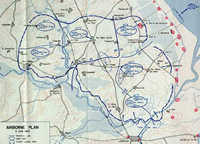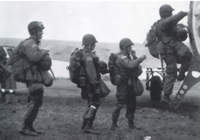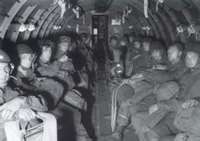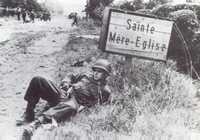Intermixed elements from both Airborne Divisions, joined together
to take orders from commanders they do not know and take on new assigned objectives.
Working hand to hand they form groups and leave to achieve missions that are assigned
to them.
The 82nd Airborne Division's 505th Parachute
Infantry Regiment's 3rd Battalion led by Lt. Col. Edward C. Krause occupied Sainte-Mere-Eglise
at 0400 hrs and declared it completely secured at 0500 hrs. The La Barquette lock
is taken in the morning by the 501st PIR, the Beach exits held by paratroopers
are relieved at 1200 hrs when contact is established with elements of the 4th
Infantry Division, which landed at Utah-Beach at 0630 hrs. By nightfall, the defensive
line seems to be stabilized on the Eastern side of the Merderet River.
The
end of the Day :
A hard fight had been fought
on D-Day by the two Divisions. Both divisions had experienced scattered drops,
with varying losses in men and material. Initial dispersion was further aggravated
by the Normandy terrain (fields with many hedgerows), this made it difficult to
assemble and still more difficult to coordinate the manoeuvre of units. Still,
the airborne operation was a success.
| 






